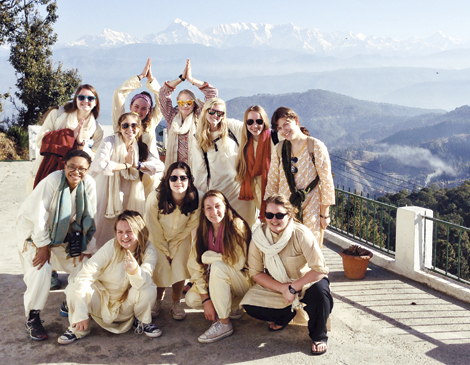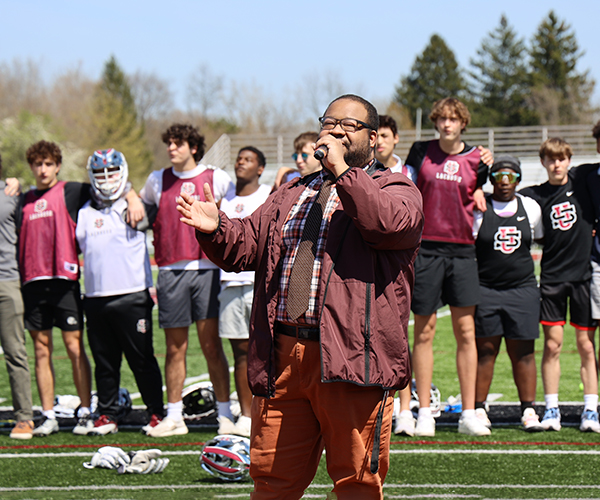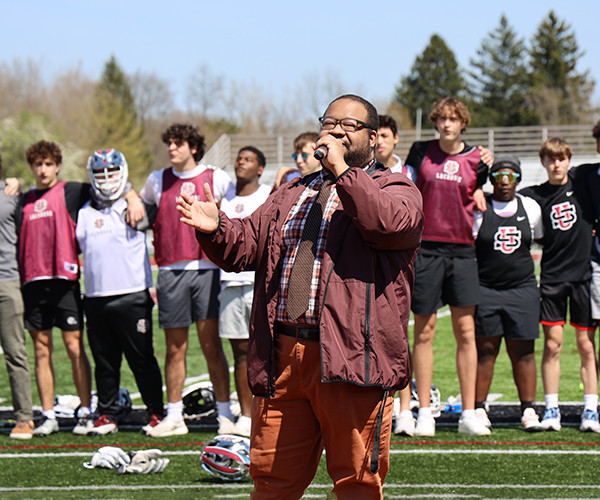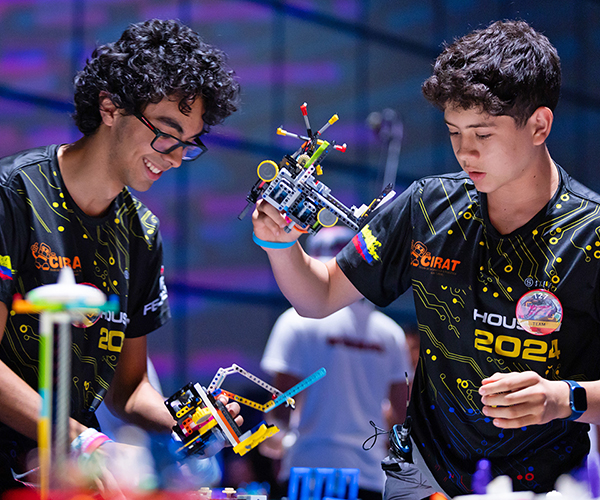We've all had that moment. Someone points out a flaw or missing link in our thinking that brings about the ultimate aha flash that makes us say, “I never thought of it that way.”
It’s the sort of sensation students can gain from group work done right. Different perspectives bubble to the surface when students dig in to collaborative classwork, says Julia Hontaruk-Levko, a 17-year-old senior at St. Joseph Academy.
AP Government students at St. Joseph are divided into clusters to complete a year-end project where they explore a topic of their choice. “It’s very open-ended in the sense that we can pick a topic relative to politics or anything going on in the news,” says Hontaruk-Levko.
Her group tackled the USA Gymnastics sexual abuse scandal, when national team doctor Larry Nassar was convicted of assaulting numerous young gymnasts. The project included small-group discussion, gathering viewpoints and ultimately presenting the case to the class.
“It’s a charged topic because, as a woman, it’s a reality that we face sexual harassment or inequity in jobs,” Hontaruk-Levko says, “and so the background based on what we see in our own daily lives provides some healthy friction.” She also says that her interest in the legal field fueled insights about the disparity in women partners’ experiences.
During the group presentation, a gymnast in the class spoke up.
“Her thoughts and opinions were more poignant because she was a gymnast,” Hontaruk-Levko says. “This experience emphasized the importance of considering people’s opinions and backgrounds in collaboration.”
Deeper engagement and a greater sense of accountability are two key benefits of collaborative learning, say Cathy Knittel, who
co-teaches the St. Joseph class Facing History and Ourselves: The American Experience with Nick Roaldi.
“Terms like ‘interdisciplinary,’ ‘interconnected,’ ‘global,’ ‘interdependent’ are quite commonplace in our language and experience today,” Knittel says. “We see that increasing as time moves forward.”
Fourth-graders in Laurel School’s Power and Purpose program, steered by teacher Shannon Lukz, learn that everyone in a group has a role to play and a responsibility to contribute. It’s a lesson they actually felt as 24 girls in the program and three adults built a bridge and carried it to a stream on the school’s Butler Campus.
“Because of how the project was designed and planned, the girls knew they had to do their part or it would not happen,” Lukz says of the problem-solving and hands-on math and science the bridge project demanded. “It makes the curriculum feel real because they are utilizing geometry and measurement in ways that impact the outcome.”
Students can feel more invested in learning when they’re participating in a group. “When curriculum and projects are meaningful,” Lukz says, “it increases the desire and urgency to share their ideas and make sure classmates understand their thinking. It feels more high-stakes when they are invested in the work because they care about what they are doing and how it will turn out.”
Effective collaboration is more than group work. It goes beyond cooperation.
When students collaborate to solve a problem, share views, overcome disagreements and create an outcome they own as a team, they experience a deeper, practical learning that they’ll actually use in the real world. According to the book Working for Equity in Heterogeneous Classrooms by Elizabeth G. Cohen and Rachel A. Lotan, “When students exchange ideas and insights, they work through misunderstandings, absorb content more effectively and help each other achieve true understanding.”
Matthew Jordan, dean of the Jack, Joseph & Morton Mandel Humanities Center at Cuyahoga Community College, points out that with the vast majority of careers students might pursue, there is going to be some engaging and partnering to get things done.
“Collaborative educational experiences are a great way to help students cultivate the skills they need,” he says.
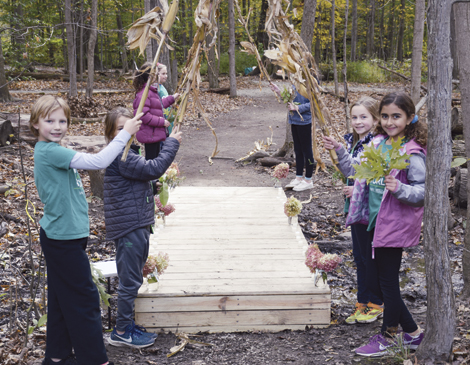
Better Together
While the idea of group work might cause visions of overbearing know-it-alls taking over while other members slack-off, Jordan boils down the benefits to three related advantages of collaboration in the classroom.
First comes practical, hands-on experience working in a group with different people.
Second, which digs deeper, is the idea that collaboration encourages creativity. For example, Jordan requires students in group environments to come up with multiple solutions before they move forward on a project.
“You are never allowed to have just one idea,” he says, “because what tends to happen in student groups and in the workplace is a group will frequently land on the very first suggestion made. The person who speaks first and loudest — their idea becomes the ‘thing we are doing.’ ”
Creativity blossoms when groups are guided to brainstorm the possibilities first, and then discuss ideas with equal attention before deciding on a direction.
For a third benefit, Jordan says that collaborative projects in an educational setting can teach students to see problems from multiple points of view. “When you get students working together on a project where they have to team up with someone who doesn’t necessarily share their views on a topic they care about, that can be a terrific way to get people to see a controversial issue from someone else’s point of view,” he says.
Working through that tension is when learning happens.
St. Joseph senior Hontaruk-Levko relates how groups she has participated in at school required everyone to stop and, well, regroup. “If we were disagreeing on something, we would stop and be like, ‘OK, here are the merits to this side, and the merits to the other view,’ ” she says. “And we’d try to figure out a middle ground — maybe not necessarily agreeing, but at least stopping to look at the facts.”
It’s an example of how collaboration can foster listening skills.
All of these qualities are what today’s employers seek in job candidates. According to an Association of American Colleges and Universities report, employers greatly endorsed broad learning and crosscutting skills as the best preparation for career success.
The research showed 96 percent of the employers surveyed agreed that the capacity to think critically, communicate clearly and solve complex problems are more important than a student’s undergraduate major. In fact, 96 percent of respondents said students should have experiences that teach them to solve problems with people whose views are different than their own. Meanwhile, 73 percent of employers think requiring college students to complete a significant applied-learning project before graduation would better prepare them for careers.
In the real world, most businesses aren’t silos of specialists who just do one thing — even in professional services firms. An
accounting group likely includes people who specialize in different aspects of the field, along with support staff who bring different skills to the company. Innovative companies introducing new products need employees with a range of disciplines:
engineers, designers, or right- and left-brained folks who work together.
J.R. Campbell, who launched Kent State University’s TechStyleLAB, points out that the economy is moving toward a more project-based environment, where people are hired to work on teams that solve problems and introduce innovations. Campbell heads up the Design Innovation initiative, where students from different disciplines collaborate on projects, such as a Fashion Tech Hack-A-Thon where they create wearable technology.
“We are moving toward an era in which our graduates need to reflect on their strengths as a member of a team,” he says, “and then take on projects and challenges where they are intentionally seeking out people who are not like them to solve problems.”
Campbell notes a move toward freelance employment options and peer-to-peer projects. “More of our graduates are building their financial livelihood by working in this [project-based] way instead of taking one job with one employer,” Campbell says.
Campbell cautions that we don’t even know exactly what jobs will look like a couple decades down the road. “We need to reconfigure what we do to help create robot-proof and AI-proof graduates so students can walk into the future and add value,” he says.
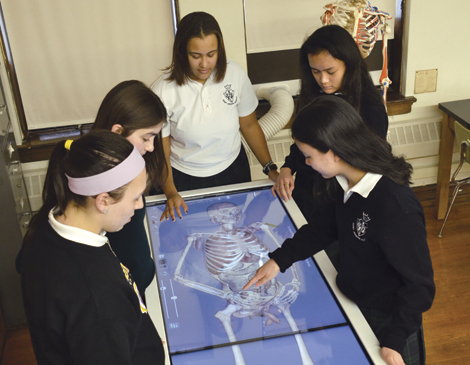
Group Dynamics
Truly effective, rewarding collaboration involves some work on the part of educators, and many schools are dedicating time and resources toward thoughtfully creating group work scenarios that bring students all of the benefits.
Integrated learning, which involves pulling ideas from several subjects to improve student achievement, inherently includes collaboration. When Hawken School began mapping its curriculum and discovered intersections between different teachers’ lesson plans, it shifted the mindset at the school, says Erin Thomas, assistant director of the middle school.
For example, students in eighth grade humanities were learning about social justice. So art classes were integrated into those lessons with visual projects, where students grouped up and discussed an issue they’d like to study via artwork.
Teachers can get in on the fun and learning too. Every year, Hawken teachers white-board a list of subjects they wish they could teach, which includes everything from photography to fly-fishing. Intersections are drawn between these ideas — like one educator who wanted to explore animals’ survivorship in winter combining a class with photography and hiking. The result is Hawken’s Insights courses. The 12 to 16 courses are offered to students during the week before spring break.
“They are passion-driven by the teachers,” Thomas says, adding that the collaborative nature of these classes combines students with different interests into the same groups.
A focus on creating collaborative experiences in the curriculum — authentic scenarios incorporating problem-solving and hands-on learning — is how forward-thinking schools are approaching the old group work formula.
But students also have to learn to work in groups. Just because they are clustered up and assigned a challenge doesn’t mean they’ll figure out how to navigate disagreements, give everyone a voice and churn out a creative result.
Laurel starts teaching collaboration in kindergarten, says fourth grade teacher Lukz. “Fostering collaboration from day one involves providing a community that honors each individual and emphasizes listening and understanding and appreciating one another,” she says. “That has to happen if you are going to ask students to work together.”
The teacher sets the tone for collaboration. Parents can also reinforce these concepts at home, Lukz points out.
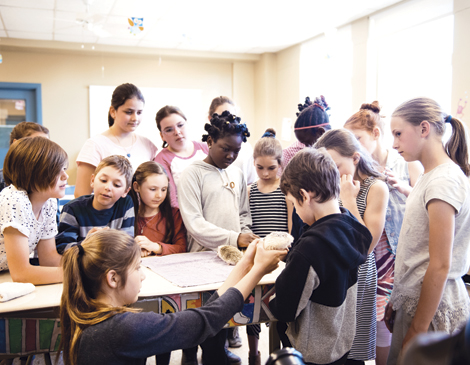
Ideally, group projects should be mapped out for students so they understand the responsibilities required and what jobs are needed to complete the work, Thomas adds. She describes an integrated unit on biomimicry, which entails approaching innovation sustainably by looking to how nature solves problems.
“Before the groups started, we had the kids look at a chart and see the pieces of the entire project,” she describes. “Then they worked to figure out what they’d like to do. Tasks were delegated in advance, so they knew their roles when it was time to move forward.”
Also helpful is leading students through exercises to help them identify how they act in a group. “We look at the different types of leadership and help students identify themselves as leaders,” Thomas says.
Instructors help students explore their own identities, and then they are more likely to understand where they fit in and how their strengths lend to group work. For example, a quiet leader leads by example. And while introverts can often feel shut out of a group, there is a way to avoid this common issue.
“Introverts have lots of strength and power,” Thomas says. “Giving kids processing time before they meet with the group so they can write down their ideas is helpful.”
To solve the perennial group work problem of someone not holding up their end of the bargain, Tri-C’s Jordan says students need to rise above the fray. While frustrating, this real-life lesson can be just as valuable as walking away from the ideal collaborative experience.
“It’s not fair,” he acknowledges. “But you’re either going to succeed or fail because you were willing to step up to the plate and do more than your fair share — or you weren’t. That can be a valuable experience.”
Besides, Jordan points out, it’s good material for a college entrance interview. (He gives this advice to his own kids.) “Put those experiences into a mental file,” he says. “Then you have a terrific story about facing adversity or demonstrating leadership.”
Hontaruk-Levko has been there. “In those situations, I pick up the ball and take one for the team,” she says. “It’s not fair, but it’s
better to get the project done correctly.”
Collaborative learning is chock-full of teachable moments, St. Joseph teacher Roaldi
notes. The tough times present opportunities to learn. “Students might submit a short reflection after a collaborative learning experience where we ask them to consider what went well, what did not go well and how they might adjust on a future group assignment,” he says.
A drive to succeed has helped Hontaruk-Levko and her peers deal with the inevitable letdowns collaborative learning can bring — just like real life.
Group work has pushed her to get her ideas out there. “Group work doesn’t come naturally to everyone,” she says. “I know it doesn’t to me. But putting my best foot forward, especially in groups, reflects on everyone as a whole and motivates me to move outside of my comfort zone.”

